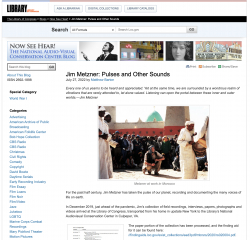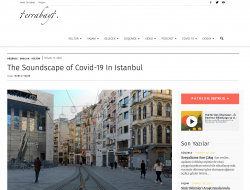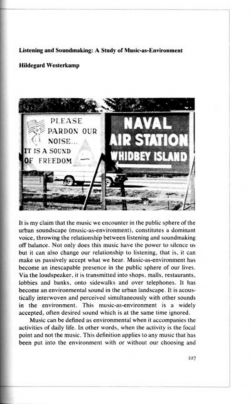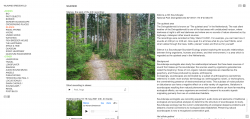Jim Metzner: Pulses and Other Sounds

Type
Other
Category
Article
[ Browse Items ]
Publication Year
2022
Publisher
Library of Congress, United States
URL
[ private ]
Abstract
For the past half century, Jim Metzner has taken the pulse of our planet, recording and documenting the many voices of life on earth.
In December 2019, just ahead of the pandemic, Jim’s collection of field recordings, interviews, papers, photographs and videos arrived at the Library of Congress, transported from his home in upstate New York to the Library’s National Audiovisual Conservation Center in Culpeper, VA.
The paper portion of the collection has been processed, and the finding aid for it can be found here: //findingaids.loc.gov/exist_collections/ead3pdf/mbrsrs/2020/rs020004.pdf.
In 2018, Jim appeared at the Library of Congress for an evening of “Sounds, Stories and Surprises.” You can view it here: //www.loc.gov/item/webcast-8522/
Jim is well known as the creator, host and producer of the syndicated radio series and podcast “Pulse of the Planet,” on the air from 1989 to the present.
Metzner has been mapping and recording the sounds of our world since the 1970s, starting locally on Boston radio and expanding outward across the globe and inward into the unseen world of plants, animals and our own bodies. In that quest, he has traveled widely, and documented many soundscapes, individuals and events around the US and the world, from the Japanese stock exchange to New York’s Saratoga racetrack to a “dawn chorus” of macaws, chachalacas, parakeets, doves, cicadas, blackbirds and other wildlife recorded in the Pantanal wetlands of Brazil. He has made similarly eclectic recordings of people, places and things in Alaska’s Toolik Lake, Anza-Borrego Desert State Park in California, Sapelo Island in Georgia, Australia, Costa Rica, Cuba, Florida, Germany, Austria, Switzerland, Greece, Crete, Ireland, and Nepal.
His collection reaches back into the 1970s, when ¼” tape decks and portable cassette recorders were the tools of the trade. In his early days on radio, he produced two locally-flavored series “You’re Hearing Boston” and “You’re Hearing San Francisco.” These programs were well received in their home markets, and are now rich time capsules filled with stories and sounds recorded at the source, memorializing the people and sonic realms of two major cities that changed enormously and irrevocably in the ensuing decades. These successes enabled him to broaden his focus on his first nationally syndicated series, “You’re Hearing America.”
Next, Metzner produced the daily two-minute program “Sounds of Science” for three years starting in 1985, creating over 500 original programs. In spite of the inherent time limitations, he presented a range of complex topics, engaging with key figures in different fields, such as Dr. Charles Munn, who guided listeners through the sounds of the Amazonian rain forest; geologist Mary Emma Wagner, who explained and demonstrated the phenomenon of resonating or “ringing” rocks; famed entomologist E.O. Wilson, speaking of consilience, biophilia and, of course, ants; Richard Leakey on the importance of conservation; engineer Linsey Marr discussing cutting edge research on airborne particles; and Brazilian shaman Kinnikinau, Chief Raoni of the Kayapo, and dozens of other First Nations spokespersons imparting the wisdom of indigenous knowledge.
For 33 years, ending on June 3rd of this year, Jim produced “Pulse of the Planet,” which was heard daily on over 200 stations in the US and in a daily podcast. It continues now as a long form tri-weekly podcast. Though science and the natural world are central topics, “Pulse” has often reached into arts and culture. Along the way, he has also produced features for public radio’s “Marketplace,” “All Things Considered” and “Weekend Edition,” as well as for “National Geographic” Online, the Discovery Channel, the American Museum of Natural History, the American Association of Engineering Societies and NASA.
“In a two minute program like ‘Pulse of the Planet’, we cherry-pick a few moments culled from hours of interviews and raw sound,” Jim notes. “Now, for the first time, you’ll be able to experience this rich resource of recordings at length and in depth, and there are some real gems here.” Imagine sitting down for a spirited conversation with the likes of Jane Goodall, Temple Grandin, Neil deGrasse Tyson, Craig Venter, Wally Schirra, Gary Burton, Arlo Guthrie, Alan Lomax, Neil Gaiman and Isaac Asimov; or listening to the sounds of an Australian cloud forest, a Japanese pottery village, a caravan in Nepal, the ancient alleyways of Fez, Morocco, or the sonorous streets of Bahia, Brazil, plus the sounds of virtually every animal you ever heard of–from ants to zebras.”
All of Metzner’s programs begin as several hours of raw, uncut recordings which are shaped and framed for listeners. The uncut recordings of interviews, actualities and soundscapes are included in the collection and add greatly to its research and historical value. Included are many encounters with noted scientists, inventors, writers and others as well as many little known or unknown people with special accomplishments or experiences that they related to Metzner over the years. Alongside a San Francisco woman’s vivid memories of the 1906 earthquake recorded more than 70 years later, you will also find interviews with people such as “Game of Thrones” author George R.R. Martin; musicians Pauline Oliveros, Tito Puente and George Shearing; Buddhist scholar Robert Thurman; ventriloquist Paul Winchell; paleontologist Stephen Jay Gould; marine biologist Sylvia Earle; paleontologist Michael Novacek; ornithologist Helen Hays; and ethnobotanist Richard Evans Schultes.
Sound itself is often the focus of Jim’s work, and the hallmark of his many series has been the distinctive use of ambient sound to illustrate the subject at hand, whether the topic be ant communication or tornado prediction.
As a Fulbright Specialist in Media and Communication, Jim has given lectures, demonstrations and master classes in Germany, Austria and Switzerland, and is looking forward to working in this capacity at the University of Otago in New Zealand, as soon as conditions allow.
“Listening back to some of the pure, unadulterated sounds in the collection–four decades worth,” Jim observes. “They still ring true, whether it’s a dawn chorus or an urban soundscape. The archive isn’t about me, but what I was privileged to witness and record. I’m grateful to the Library of Congress for enabling these sounds to be shared with the public for generations to come. For those interested in learning more about recording and documenting the sounds around us, I’ve launched the American Soundscapes Project which aims to crowd-source, collect and share the sounds that are important to us. Visit americansoundscapes.com to learn more.”
In December 2019, just ahead of the pandemic, Jim’s collection of field recordings, interviews, papers, photographs and videos arrived at the Library of Congress, transported from his home in upstate New York to the Library’s National Audiovisual Conservation Center in Culpeper, VA.
The paper portion of the collection has been processed, and the finding aid for it can be found here: //findingaids.loc.gov/exist_collections/ead3pdf/mbrsrs/2020/rs020004.pdf.
In 2018, Jim appeared at the Library of Congress for an evening of “Sounds, Stories and Surprises.” You can view it here: //www.loc.gov/item/webcast-8522/
Jim is well known as the creator, host and producer of the syndicated radio series and podcast “Pulse of the Planet,” on the air from 1989 to the present.
Metzner has been mapping and recording the sounds of our world since the 1970s, starting locally on Boston radio and expanding outward across the globe and inward into the unseen world of plants, animals and our own bodies. In that quest, he has traveled widely, and documented many soundscapes, individuals and events around the US and the world, from the Japanese stock exchange to New York’s Saratoga racetrack to a “dawn chorus” of macaws, chachalacas, parakeets, doves, cicadas, blackbirds and other wildlife recorded in the Pantanal wetlands of Brazil. He has made similarly eclectic recordings of people, places and things in Alaska’s Toolik Lake, Anza-Borrego Desert State Park in California, Sapelo Island in Georgia, Australia, Costa Rica, Cuba, Florida, Germany, Austria, Switzerland, Greece, Crete, Ireland, and Nepal.
His collection reaches back into the 1970s, when ¼” tape decks and portable cassette recorders were the tools of the trade. In his early days on radio, he produced two locally-flavored series “You’re Hearing Boston” and “You’re Hearing San Francisco.” These programs were well received in their home markets, and are now rich time capsules filled with stories and sounds recorded at the source, memorializing the people and sonic realms of two major cities that changed enormously and irrevocably in the ensuing decades. These successes enabled him to broaden his focus on his first nationally syndicated series, “You’re Hearing America.”
Next, Metzner produced the daily two-minute program “Sounds of Science” for three years starting in 1985, creating over 500 original programs. In spite of the inherent time limitations, he presented a range of complex topics, engaging with key figures in different fields, such as Dr. Charles Munn, who guided listeners through the sounds of the Amazonian rain forest; geologist Mary Emma Wagner, who explained and demonstrated the phenomenon of resonating or “ringing” rocks; famed entomologist E.O. Wilson, speaking of consilience, biophilia and, of course, ants; Richard Leakey on the importance of conservation; engineer Linsey Marr discussing cutting edge research on airborne particles; and Brazilian shaman Kinnikinau, Chief Raoni of the Kayapo, and dozens of other First Nations spokespersons imparting the wisdom of indigenous knowledge.
For 33 years, ending on June 3rd of this year, Jim produced “Pulse of the Planet,” which was heard daily on over 200 stations in the US and in a daily podcast. It continues now as a long form tri-weekly podcast. Though science and the natural world are central topics, “Pulse” has often reached into arts and culture. Along the way, he has also produced features for public radio’s “Marketplace,” “All Things Considered” and “Weekend Edition,” as well as for “National Geographic” Online, the Discovery Channel, the American Museum of Natural History, the American Association of Engineering Societies and NASA.
“In a two minute program like ‘Pulse of the Planet’, we cherry-pick a few moments culled from hours of interviews and raw sound,” Jim notes. “Now, for the first time, you’ll be able to experience this rich resource of recordings at length and in depth, and there are some real gems here.” Imagine sitting down for a spirited conversation with the likes of Jane Goodall, Temple Grandin, Neil deGrasse Tyson, Craig Venter, Wally Schirra, Gary Burton, Arlo Guthrie, Alan Lomax, Neil Gaiman and Isaac Asimov; or listening to the sounds of an Australian cloud forest, a Japanese pottery village, a caravan in Nepal, the ancient alleyways of Fez, Morocco, or the sonorous streets of Bahia, Brazil, plus the sounds of virtually every animal you ever heard of–from ants to zebras.”
All of Metzner’s programs begin as several hours of raw, uncut recordings which are shaped and framed for listeners. The uncut recordings of interviews, actualities and soundscapes are included in the collection and add greatly to its research and historical value. Included are many encounters with noted scientists, inventors, writers and others as well as many little known or unknown people with special accomplishments or experiences that they related to Metzner over the years. Alongside a San Francisco woman’s vivid memories of the 1906 earthquake recorded more than 70 years later, you will also find interviews with people such as “Game of Thrones” author George R.R. Martin; musicians Pauline Oliveros, Tito Puente and George Shearing; Buddhist scholar Robert Thurman; ventriloquist Paul Winchell; paleontologist Stephen Jay Gould; marine biologist Sylvia Earle; paleontologist Michael Novacek; ornithologist Helen Hays; and ethnobotanist Richard Evans Schultes.
Sound itself is often the focus of Jim’s work, and the hallmark of his many series has been the distinctive use of ambient sound to illustrate the subject at hand, whether the topic be ant communication or tornado prediction.
As a Fulbright Specialist in Media and Communication, Jim has given lectures, demonstrations and master classes in Germany, Austria and Switzerland, and is looking forward to working in this capacity at the University of Otago in New Zealand, as soon as conditions allow.
“Listening back to some of the pure, unadulterated sounds in the collection–four decades worth,” Jim observes. “They still ring true, whether it’s a dawn chorus or an urban soundscape. The archive isn’t about me, but what I was privileged to witness and record. I’m grateful to the Library of Congress for enabling these sounds to be shared with the public for generations to come. For those interested in learning more about recording and documenting the sounds around us, I’ve launched the American Soundscapes Project which aims to crowd-source, collect and share the sounds that are important to us. Visit americansoundscapes.com to learn more.”
Description
https://blogs.loc.gov/now-see-hear/2022/07/jim-metzner-pulses-and-other-sounds/
Number of Copies
1
| Library | Accession No | Call No | Copy No | Edition | Location | Availability |
|---|---|---|---|---|---|---|
| Main | 657 | 1 | Yes |




